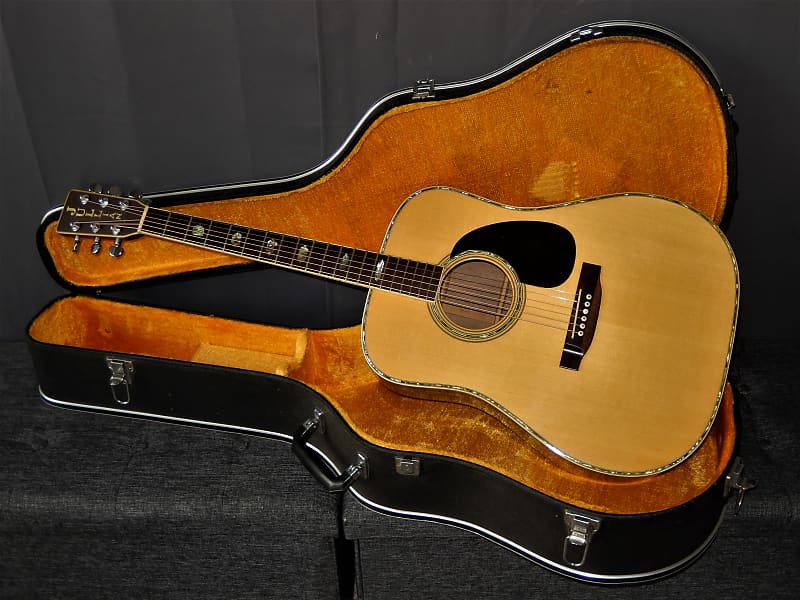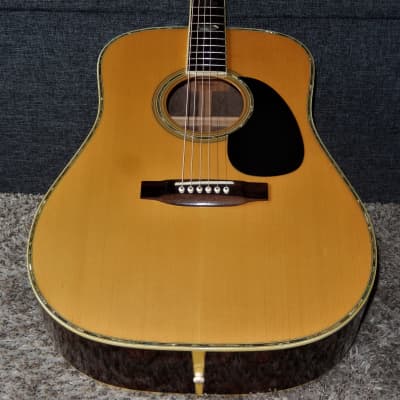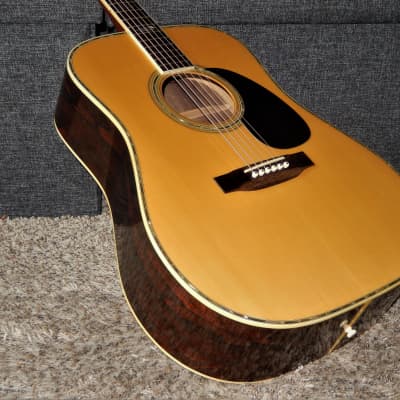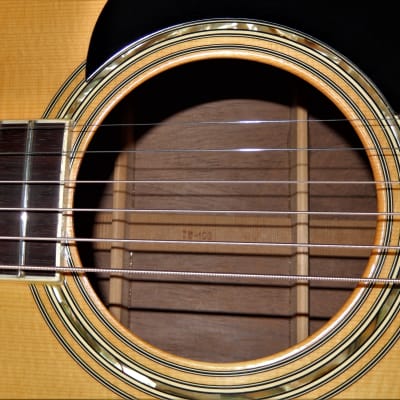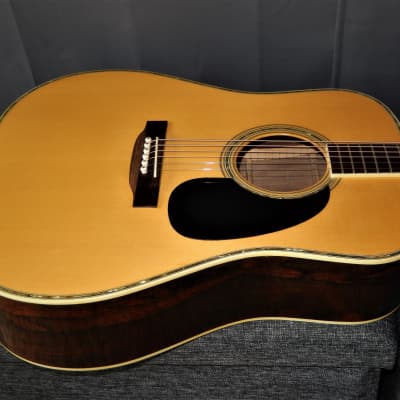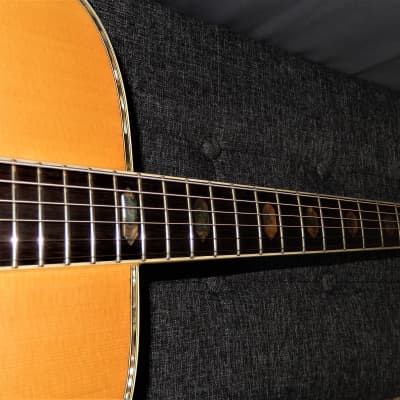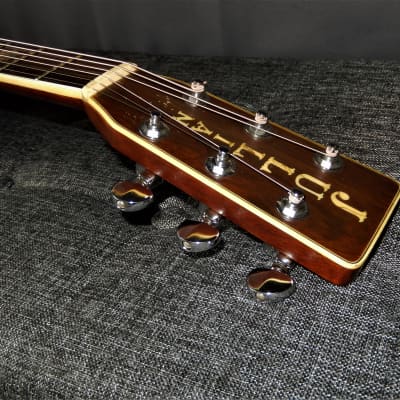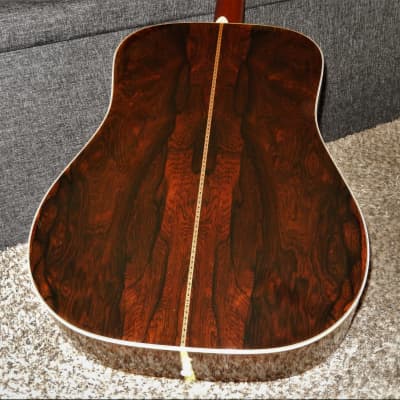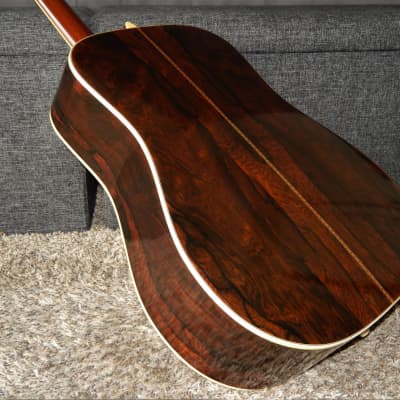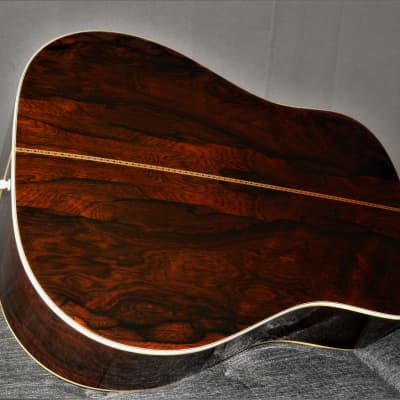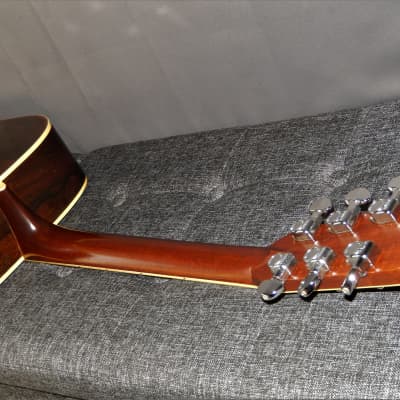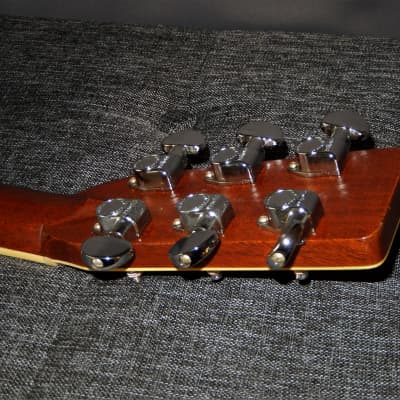Several hundred guitars I have sold in the past are presented at Facebook.com/Victors.Guitar.Library.
Jullian TW100 1976
This terrific guitar was made in 1976 being the very top model in Tsunesaburo Kurosawa’s line of acoustic guitars branded as “Jullian”. These guitars were made only since early through mid1970s.
Tsunesaburo Kurosawa was a great luthier himself, making terrific classical and flamenco guitars. Among the other apprentices, he trained and promoted his famous nephew, Sumio Kurosawa (who later reached for the very top among Japanese elite luthiers). Tsunesaburo however had great business drive and in late 1960s established his own HITACHI guitar factory. In following years he started to build a chain of his own music stores all over Japan. As of today Kurosawa’s network is the largest domestic distributor and retailer of musical instruments in Japan.
This guitar surely deserves “Grand Concert” title. It offers impressive volume and superb response. Its sound is quite deep yet ultra-rich. Basses are deep but very “clean”. Trebles are metallic but sweet at the same time. All notes have their unique colors, all are super clear and super well separated. When chords and arpeggios are played guitar releases a plenty of overtones and harmonies. All notes are magnified by very impressive sustain. Yet it is not “all solid woods” construction guitar.
This guitar was priced 100 000 yen in 1976. Yet it is not “all solid woods” construction guitar.
In Japan of 1976 one could easily find all solid woods acoustic guitar for 80000 yen (e.g. Yamaki YW80) while solid top model for 40000 yen (e.g. Takamine Elite TW40) or perhaps even less than that. Within 80000-100000 yen price range there were many all solid woods (usually with Indian Rosewood b/s) models and many solid top models made with non-solid Brazilian Rosewood b/s. Many guitars made with non-solid BR b/s were priced higher than many all solid woods models. For the same 100 000 yen price one could chose a guitar made with non-solid BR (e.g. Yamaki F1100, Takamine Elite TW100) or with solid Indian Rosewood b/s (e.g. Matsuoka D100, Sadao Yairi YD305) or even solid BR b/s (e.g. Yamaha FG1000). In general, on Japanese market of that era certain price meant certain grade of the guitar, regardless of its construction. However, some companies (e.g. Yamaha) were choosing to lower their margins as part of their marketing strategy.
During that era, it was common for Japanese makers to create double structure (2 laminated plates not glued together) backs or sides on their higher end model. This construction always meant greater volume and response, and tonality richer than that offered by “all solid woods” models. Very likely this guitar was made that way.
If you wanted to purchase hand made in Japan brand new guitar with the same construction and looks you could possibly find one for $3500. However, if you wanted this guitar to be made from 40+ years old woods and sound like vintage one, you would need to spend at least $5000.
It is not that very difficult to find out what are the current prices for acoustic guitars hand made in Japan.
Despite few tiny dents and light scratches within the finishes on its body and no longer white original bindings, this guitar remains in overall excellent “for its age” condition. Its original Grover tuners still look like new. Its neck is straight, fingerboard and its levelled frets in great shape. With its quite low action it plays super easy.
Specifications:
Top: Solid Spruce/ Martin style bracing with non-scalloped braces/ thin coat of lacquer
Back & Sides: Non-Solid Brazilian Rosewood/urethane
Very likely this guitar has either double structure back or double structure sides. Double structure means 2 “laminated” plates not glued together.
Fingerboard: Very well smoothed Brazilian Rosewood with the feel of Ebony
Neck: Mahogany
Scale 645 mm
Width at Nut: 43 mm
Its action is set to 2.50 mm under E6 and 2.00 mm under E1 with still extra room on the saddle
My posted for sale guitars are stored in climate-controlled vault already packed into shipping boxes, with loosen strings. Because the strings are loosened, they don’t pull the neck or soundboard, and the neck may relax (straighten more) and the soundboard flatten a bit, which may result with the string action being lower than my it was with my original settings and lead to buzzes and/or dead notes after guitar arrives to you. Such a change in neck curvature can also happen just because of vibrations during the shipment and/or temperature fluctuations. Therefore, you must be ready to make final action adjustment yourself and or have it done by professional. All that really needs to be done is the simple neck adjustment by using the truss rod (turning the truss rod counterclockwise will relief the neck and strings will move away from the frets).
THAT IS WHY TRUSS RODS ARE INSTALLED IN THE NECKS OF ACOUSTIC GUITARS!!!
This guitar will be shipped in used original hard shell case in still very good condition.
When contemporary Japanese luthiers are using 40+ years old soundboards to make “all solid woods” guitar it is priced at least $5000USD. Guitars with artificially aged (“baked”) soundboards are priced at least $4500USD. Solid top models with 40+ years old soundboards are priced at least $3500USD. American, Australian and European luthiers usually charge 50% more.
It is a matter of basic education (not beliefs) to realize that 50+ years old soundboard of this guitar alone is worth $2500USD.
The key to understand value of vintage Japanese guitars is to acknowledge galloping price inflation (devaluation of Japanese yen) during 1960s & 1970s. This inflation slowed down in 1980s.
During 1960s and most of 1970s model numbers of Japanese guitars were strictly interconnected with their prices in Japanese yen. By early 1980s and during following decades model numbers were no longer strictly associated with their prices. Some Japanese guitar makers introduced model names instead of model numbers. Others were still using model numbers with addition of letters and/or other symbols.
It is then important to understand that two Yamaha GC10 guitars made 10 years apart are two instruments of totally different class. The same applies to any other Japanese maker/brand.
The logical way to estimate the true class of any given Japanese made instrument is to compare its price with the average annual salary of wage workers in Japanese private sectors. This salary was: 450 600 yen in 1965 - 825 900 yen in 1970 - 1 868 300 yen in 1975 - 2 689 000 yen in 1980 - 3 163 000 yen in 1985 - 3 761 000 yen in 1990 - 4 107 000 yen in 1995 - 4 082 000 yen in 2000.
Any guitar priced 100 000 yen in 1970 (labelled as No10 or No100) would be priced 200 000 yen in 1975 (relabeled to No20, No200 or 2000), 300 000 yen in 1977 (labelled as No3, No30 or 3000) and 500 000 yen by 1985 (labelled as No50 or 5000).
Starting in 1977 Masaru Kohno introduced his new models No40 priced 400 000 yen and No50 priced 500 000 yen. By early 1980s Kohno started using model names instead of numbers and was steadily raising their prices without changing model labeling. His very top model 50 became model “Special”, and a decade later it became model “Maestro”. Naturally, all other Japanese guitar makers were doing similar pricing (labelling) upgrades.
Knowing all of that, you can bet on that Masaru Kohno No50 made in 1982 is practically the same grade instrument as Kohno No20 made in 1972, or Kohno no 30 made in 1975.
In early 1970s the lowest Ryoji Matsuoka (all plywood) model was 10, followed by (solid top) models 15, 20, 25, 30, 40, 50, 60, 80 and (all solid woods) models 100 and 150. Models 50, 60 and 80 were made with non-solid figured Brazilian Rosewood (double) back and sides and top model 150 was the only one made with solid figured Brazilian Rosewood b/s.
In 1980 the lowest Matsuoka model was (all plywood) 20, followed by (solid top) models 30,40,50, 60 and all solid woods models 80,100,150 and 200. By 1990 the lowest Matsuoka model was M40 and the highest was M300. By 2010 the lowest Matsuoka model was M50 and the top model was M270.
You can bet that Ryoji Matsuoka model 50 from 1980 is of the same grade as model M100 from 2000, model 100 from 1980 is of the same grade as model M150 from 2000, model 150 from 1980 is of the same grade as M200 from 2000 and model 200 from 1980 is of the same grade as model M300 from 2000.
It is important to mention that if modern era luthiers are using 40+ years old woods to make an “all solid” wood classical guitar, its price is minimum $8000.
All vintage guitars made with Brazilian Rosewood are especially precious, including those made straight grain varieties and those with non-solid b/s.
Because response and tonal properties of Spruce soundboards are improving over time, long seasoned Spruces are far more precious than long seasoned Cedars.
It is not very difficult to find out what are current prices of such guitars made by world’s leading luthiers.
